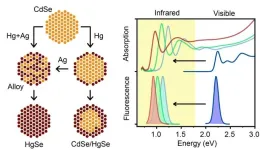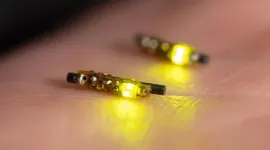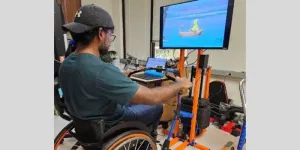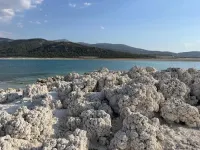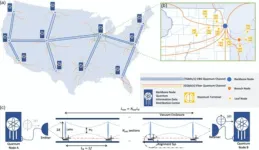(Press-News.org) A international team of astronomers led by Université de Montréal has made an exciting discovery about the temperate exoplanet LHS 1140 b: it could be a promising "super-Earth" covered in ice or water.
When the exoplanet LHS 1140 b was first discovered, astronomers speculated that it might be a mini-Neptune: an essentially gaseous planet, but very small in size compared to Neptune. But after analyzing data from the James Webb Space Telescope (JWST) collected in December 2023 - combined with previous data from other space telescopes such as Spitzer, Hubble and TESS - scientists have come to a very different conclusion.
Located some 48 light-years from Earth in the constellation Cetus, LHS 1140 b appears to be one of the most promising exoplanets in its star's habitable zone, potentially harboring an atmosphere and even an ocean of liquid water. The results of this discovery by Université de Montréal astronomers are available on ArXiv and will soon be published in The Astrophysical Journal Letters.
An exoplanet in the 'Goldilocks' Zone'
LHS 1140 b, an exoplanet orbiting a low-mass red dwarf star roughly one-fifth the size of the Sun, has captivated scientists due to it being one of the closest exoplanets to our Solar System that lies within its star’s habitable zone. Exoplanets found in this “Goldilocks’ Zone” have temperatures that would allow water to exist on them in liquid form — liquid water being a crucial element for life as we know it on Earth.
Earlier this year, researchers led by Charles Cadieux, a Ph.D. student at UdeM's Trottier Institute for Research on Exoplanets (iREx) supervised by professor René Doyon, reported new mass and radius estimates for LHS 1140 b with exceptional accuracy, comparable to those of the well-known TRAPPIST-1 planets: 1.7 times the size of Earth and 5.6 times its mass.
One of the critical questions about LHS 1140 b was whether it is a mini-Neptune type exoplanet (a small gas giant with a thick hydrogen-rich atmosphere) or a super-Earth (a rocky planet larger than Earth). This latter scenario included the possibility of a so-called “Hycean world” with a global liquid ocean enveloped by a hydrogen-rich atmosphere which would exhibit a distinct atmospheric signal that could be observed using the powerful Webb Telescope.
New insights from Webb data
Through an extremely competitive process, the team of astronomers obtained valuable "drector's discretionary time" (DDT) on Webb last December, during which two transits of LHS 1140 b were observed with the Canadian-built NIRISS (Near-Infrared Imager and Slitless Spectrograph) instrument. This DDT programme is only the second dedicated to the study of exoplanets in the nearly two years of Webb’s operations, underscoring the importance and potential impact of these findings.
Analysis of these observations strongly excluded the mini-Neptune scenario, with tantalizing evidence suggesting exoplanet LHS 1140 b is a super-Earth that may even have a nitrogen-rich atmosphere. If this result is confirmed, LHS 1140 b would be the first temperate planet to show evidence of a secondary atmosphere, formed after the planet’s initial formation.
Estimates based on all accumulated data reveal that LHS 1140 b is less dense than expected for a rocky planet with an Earth-like composition, suggesting that 10 to 20 per cent of its mass may be composed of water. This discovery points to LHS 1140 b being a compelling water world, likely resembling a snowball or ice planet with a potential liquid ocean at the sub-stellar point, the area of the planet’s surface that would always be facing the system’s host star due to the planet’s expected synchronous rotation (much like the Earth’s Moon).
“Of all currently known temperate exoplanets, LHS 1140 b could well be our best bet to one day indirectly confirm liquid water on the surface of an alien world beyond our Solar System,” said Cadieux, lead author of the new study. “This would be a major milestone in the search for potentially habitable exoplanets.”
Possible presence of an atmosphere and an ocean
While it is still only a tentative result, the presence of a nitrogen-rich atmosphere on LHS 1140 b would suggest the planet has retained a substantial atmosphere, creating conditions that might support liquid water. This discovery favors the water-world/snowball scenario as the most plausible.
Current models indicate that if LHS 1140 b has an Earth-like atmosphere, it would be a snowball planet with a vast "bull’s-eye" ocean measuring about 4,000 kilometers in diameter, equivalent to half the surface area of the Atlantic Ocean. The surface temperature at the centre of this alien ocean could even be a comfortable 20 degrees Celsius.
LHS 1140 b's potential atmosphere and favorable conditions for liquid water make it an exceptional candidate for future habitability studies. This planet provides a unique opportunity to study a world that could support life, given its position in its star's habitable zone and the likelihood of its having an atmosphere that can retain heat and support a stable climate.
Several years of observation ahead
Confirming the presence and composition of LHS 1140 b's atmosphere and discerning between the snowball planet and bull’s-eye ocean planet scenarios require further observations. The research team has emphasised the need for additional transit and eclipse measurements with the Webb Telescope, focusing on a specific signal that could unveil the presence of carbon dioxide. This feature is crucial for understanding the atmospheric composition and detecting potential greenhouse gases that could indicate habitable conditions on the exoplanet.
“Detecting an Earth-like atmosphere on a temperate planet is pushing Webb’s capabilities to its limits - it’s feasible; we just need lots of observing time,” said Doyon, who is also the principal investigator of the NIRISS instrument. “The current hint of a nitrogen-rich atmosphere begs for confirmation with more data. We need at least one more year of observations to confirm that LHS 1140 b has an atmosphere, and likely two or three more to detect carbon dioxide.” According to Doyon, the Webb Telescope will likely have to observe this system at every possible opportunity for several years to determine whether LHS 1140 b has habitable surface conditions.
Given LHS 1140 b's limited visibility with Webb — a maximum of only eight visits per year are possible — astronomers will require several years of observations to detect carbon dioxide and confirm the presence of liquid water on the planet's surface.
About this study
"Transmission spectroscopy of the habitable zone exoplanet LHS 1140 b with JWST/NIRISS," by Charles Cadieux et al, was published in ArXiv on June 21, 2024 and will soon be published in Astrophysical Journal Letters. Cadieux is a doctoral student at Université de Montréal's Trottier Institute for Research on Exoplanets (iREx).
Other iREx researchers who contributed to this paper are René Doyon (UdeM), Étienne Artigau (UdeM), Olivia Lim (UdeM), Michael Radica (UdeM), Salma Salhi (UdeM), Lisa Dang (UdeM), Loïc Albert (UdeM), Louis-Philippe Coulombe (UdeM), Nicolas Cowan (McGill), David Lafrenière (UdeM), Alexandrine L’Heureux (UdeM), Caroline Piaulet-Ghorayeb (UdeM), Björn Benneke (UdeM), Neil Cook (UdeM), and Marylou Fournier-Tondreau (UdeM and University of Oxford). Additional contributors are based out of the University of Michigan, the Centre national de recherche scientifique (France), NASA Goddard Space Flight Center, the American University, McGill University, McMaster University, and the University of Toronto. Cadieux and the UdeM team acknowledge financial support from the Canadian Space Agency for this study.
END
Found with Webb: a potentially habitable icy world
2024-07-09
ELSE PRESS RELEASES FROM THIS DATE:
New one-step method to make multiple edits to a cell’s genome
2024-07-09
SAN FRANCISCO, CA—Genome editing has become a widely adopted technology to modify DNA in cells, allowing scientists to study diseases in the lab and develop therapies that repair disease-causing mutations. However, with current approaches, it’s only possible to edit cells in one location at a time.
Now, a team of scientists at Gladstone Institutes has developed a new method that enables them to make precise edits in multiple locations within a cell—all at once. Using molecules called retrons, they created a tool that can efficiently modify DNA in bacteria, yeast, and human cells.
“We wanted to push the boundaries of genomic technologies ...
Moving from the visible to the infrared: Developing high quality nanocrystals
2024-07-09
Awarded the 2023 Nobel Prize in Chemistry, quantum dots have a wide variety of applications ranging from displays and LED lights to chemical reaction catalysis and bioimaging. These semiconductor nanocrystals are so small—on the order of nanometers—that their properties, such as color, are size dependent, and they start to exhibit quantum properties. This technology has been really well developed, but only in the visible spectrum, leaving untapped opportunities for technologies in both the ultraviolet and infrared regions of the electromagnetic ...
Implantable LED device uses light to treat deep-seated cancers
2024-07-09
Certain types of light have proven to be an effective, minimally invasive treatment for cancers located on or near the skin when combined with a light-activated drug. But deep-seated cancers, surrounded by tissue, blood and bone, have been beyond the reach of light’s therapeutic effects.
To bring light’s benefits to these harder-to-access cancers, engineers and scientists at the University of Notre Dame have devised a wireless LED device that can be implanted. This device, when combined with a light-sensitive ...
LA County faces dual challenge: Food insecurity and nutrition insecurity
2024-07-09
While food insecurity has long been the focus of local and national policymakers and researchers, nutrition insecurity has largely been overlooked. A new study by the Institute for Food System Equity (IFSE) at the USC Dornsife College of Letters, Arts and Sciences aims to change that.
This is the first study in Los Angeles County to identify the populations most affected by nutrition insecurity, distinct from food insecurity. Nutrition insecurity refers to a lack of access to healthy food that ...
AI can support humanitarian organizations in situations of armed conflict or crisis - but they should understand the potential risks, study warns
2024-07-09
AI can help humanitarians gain crucial insights to better monitor and anticipate risks, such as a conflict outbreak or escalation. But deploying systems in this context is not without risks for those affected, a new study warns.
Humanitarian organisations have been increasingly using digital technologies and the Covid-19 pandemic has accelerated this trend.
AI-supported disaster mapping was used in Mozambique to speed up emergency response, and AI systems were used to predict food crisis and rolled out by the World Bank across twenty-one countries.
But the study warns some uses of AI may expose people to additional harms and present significant ...
Speech Accessibility Project’s three newest partners are dedicated to people with cerebral palsy
2024-07-09
The Speech Accessibility Project is partnering with several organizations who serve people with cerebral palsy as it recruits more participants for its speech recognition technology work. They include ADAPT Community Network, the Cerebral Palsy Foundation and CP Unlimited.
The project is recruiting U.S. and Puerto Rican adults with cerebral palsy, amyotrophic lateral sclerosis, Down syndrome, Parkinson’s and those who have had a stroke. Funded by Big ...
UT Arlington increases interdisciplinary grants by 40% in 2024
2024-07-09
The Office of the Vice President for Research and Innovation at The University of Texas at Arlington has awarded seven Interdisciplinary Research Program (IRP) grants totaling nearly $140,000 to foster collaboration between groups that do not typically work together. This represents an increase in funding of 40% over the grants awarded in 2023.
“UT Arlington has increased its support of interdisciplinary research as we know that many of today’s great societal challenges ...
MIT researchers introduce generative AI for databases
2024-07-09
CAMBRIDGE, MA — A new tool makes it easier for database users to perform complicated statistical analyses of tabular data without the need to know what is going on behind the scenes.
GenSQL, a generative AI system for databases, could help users make predictions, detect anomalies, guess missing values, fix errors, or generate synthetic data with just a few keystrokes.
For instance, if the system were used to analyze medical data from a patient who has always had high blood pressure, it could catch a blood pressure reading that ...
Exponentially increasing understanding of early life on Earth
2024-07-09
Despite decades of research, there’s still much scholars don’t understand about life’s beginnings and early evolution. A UC Riverside paper has opened the door to understanding more and to framing future studies that could help predict climate change and search for life beyond Earth.
“This paper strives to inform the Earth sciences community where the research needs to go next,” said Christopher Tino, a UCR PhD candidate during the time of research and a first author.
Many studies have explored signs ...
New method could yield fast, cross-country quantum network
2024-07-09
Quantum computers offer powerful ways to improve cybersecurity, communications, and data processing, among other fields. To realize these full benefits, however, multiple quantum computers need to be connected to build quantum networks or a quantum internet. Scientists have struggled to come up with practical methods of building such networks, which must transmit quantum information over long distances.
Now, researchers at the University of Chicago Pritzker School of Molecular Engineering (PME) have proposed a new approach — building long quantum channels using vacuum sealed tubes ...




